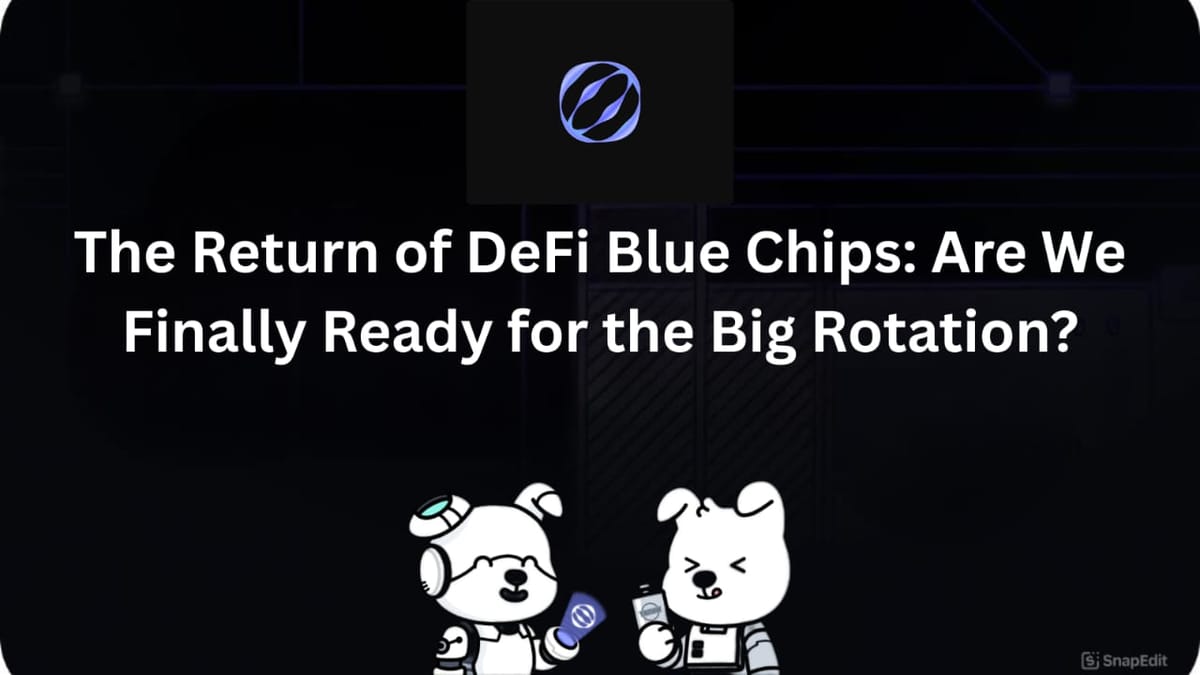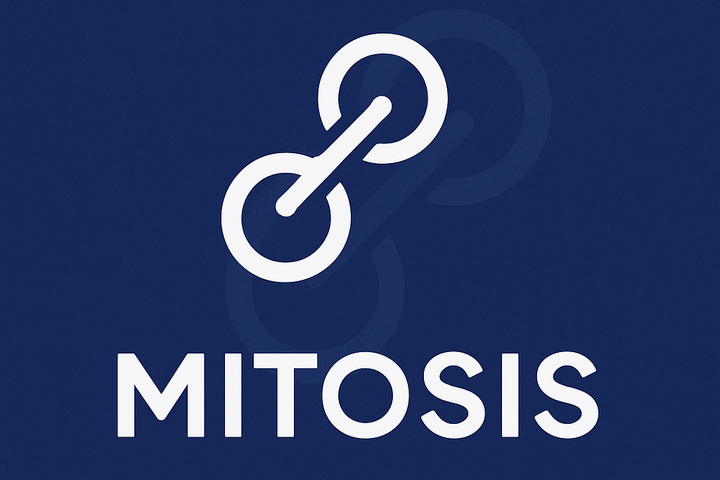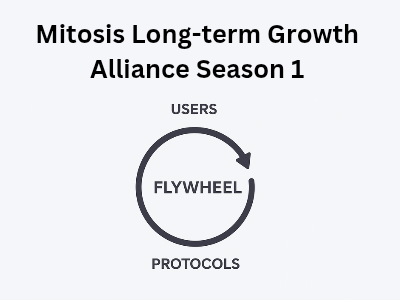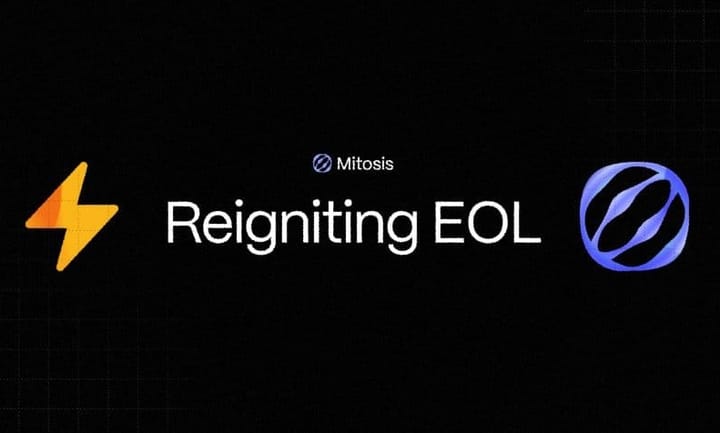The Return of DeFi Blue Chips: Are We Finally Ready for the Big Rotation?

The decentralized finance (DeFi) landscape has undergone a seismic shift over the past few years. Once heralded as the future of finance, many DeFi protocols faced significant challenges, leading to a decline in user interest and capital inflow. However, as we move into 2024, a resurgence of interest in established DeFi blue chips is becoming evident. Protocols like Aave, Synthetix, and Yearn Finance are not only rebuilding but are also innovating in ways that could redefine their roles in the DeFi ecosystem. This article delves into the factors driving this revival, the importance of governance, integrations, and real yield, and highlights other DeFi OGs that may be staging a comeback.
1. The State of DeFi: A Brief Overview
Before diving into the specifics of the blue-chip revival, it’s essential to understand the current state of DeFi. The DeFi sector, which once boasted a total value locked (TVL) in the hundreds of billions, saw a significant contraction in 2022 and early 2023. Factors contributing to this decline included:
- Market Volatility: The broader cryptocurrency market experienced extreme volatility, leading to reduced liquidity and investor confidence.
- Regulatory Scrutiny: Increased regulatory scrutiny from governments worldwide raised concerns about the future of DeFi protocols.
- Security Issues: High-profile hacks and exploits led to significant losses, causing users to withdraw their funds from DeFi platforms.
- Yield Farming Fatigue: The initial excitement around yield farming waned as users became disillusioned with unsustainable yields.
Despite these challenges, the DeFi sector is showing signs of recovery. The emergence of new use cases, improved governance models, and a focus on real yield are driving renewed interest in established protocols.
2. The Rebuilding of DeFi Blue Chips
2.1. Aave: Innovating for the Future
Aave, one of the leading lending protocols in the DeFi space, has been quietly innovating. The introduction of Aave V3 brought several enhancements, including:
- Layer 2 Support: Aave V3 expanded its reach by integrating with Layer 2 solutions like Polygon and Optimism, allowing for faster transactions and lower fees.
- Cross-Chain Functionality: The protocol introduced cross-chain capabilities, enabling users to lend and borrow assets across different blockchain networks seamlessly.
- Risk Management Features: Aave V3 introduced new risk management tools, allowing users to customize their risk exposure and lending strategies.
These innovations position Aave as a more versatile and user-friendly platform, attracting both new and returning users.
2.2. Synthetix V3: A New Era for Synthetic Assets
Synthetix, a protocol for creating synthetic assets, has also undergone significant changes with the launch of Synthetix V3. Key features include:
- Optimized Capital Efficiency: Synthetix V3 focuses on improving capital efficiency, allowing users to create synthetic assets with less collateral.
- Decentralized Governance: The protocol has enhanced its governance model, giving SNX token holders more influence over protocol decisions.
- Integration with Layer 2: Similar to Aave, Synthetix has integrated with Layer 2 solutions, improving transaction speeds and reducing costs.
These updates not only enhance the user experience but also position Synthetix as a more competitive player in the synthetic asset space.
2.3. Yearn Finance: The Return of Yield Aggregation
Yearn Finance, known for its yield aggregation strategies, is also making a comeback. The launch of Yearn V3 has introduced several new features:
- Vault Optimization: Yearn V3 focuses on optimizing vault strategies to maximize yield for users while minimizing risk.
- Enhanced User Interface: The protocol has revamped its user interface, making it more accessible for newcomers to DeFi.
- Partnerships and Integrations: Yearn has formed strategic partnerships with other DeFi protocols, enhancing its offerings and expanding its user base.
These developments signal a renewed commitment to providing value to users and adapting to the evolving DeFi landscape.
3. Governance: The Heart of DeFi Revivals
One of the critical factors driving the revival of DeFi blue chips is the evolution of governance models. Traditional governance structures often faced criticism for being slow and unresponsive. However, many protocols are now adopting more dynamic governance frameworks that empower users and foster community engagement.
3.1. Decentralized Autonomous Organizations (DAOs)
DAOs have become a popular governance model in the DeFi space. By allowing token holders to vote on protocol decisions, DAOs promote transparency and community involvement. Protocols like Aave and Synthetix have embraced this model, enabling users to propose and vote on changes, upgrades, and new features.
3.2. Quadratic Voting
Some protocols are exploring quadratic voting as a way to enhance governance. This method allows users to express the intensity of their preferences, giving them a more nuanced influence over decisions. This can prevent governance dominance by whale token holders and foster a fairer decision-making process that reflects the diverse interests of the community.
3.3. Treasury Management and Incentives
Effective treasury management is a key aspect of governance revival. Blue-chip protocols are increasingly transparent about how treasury funds are allocated, including investments into development, partnerships, and ecosystem growth. Moreover, these projects are designing incentive mechanisms that reward active governance participation, thus keeping the community engaged and aligned with the protocol’s long-term vision.
4. Integrations: Building a Connected DeFi Ecosystem
Another significant driver behind the return of DeFi blue chips is their strategic focus on integrations. Unlike the earlier years of DeFi, where protocols often operated in silos, the current iteration emphasizes interoperability and seamless integration with other platforms.
4.1. Cross-Chain Bridges and Layer 2 Solutions
Protocols like Aave and Synthetix V3 have aggressively adopted Layer 2 solutions such as Optimism, Arbitrum, and Polygon which significantly reduce gas fees and improve transaction speeds. This adoption has expanded their user base by making the platforms more accessible, especially to retail users who were often priced out by high fees on Ethereum mainnet.
Simultaneously, cross-chain bridges are enabling protocols to tap into liquidity and user bases across multiple blockchains. This interoperability reduces fragmentation and creates a more unified DeFi ecosystem critical for scaling decentralized finance to mainstream adoption.
4.2. Composability and DeFi Legos
The modern DeFi space thrives on composability, building protocols that can plug into one another like Legos. Blue-chip protocols are investing heavily in developer tools, APIs, and SDKs that encourage other projects to integrate their services. For instance, Yearn Finance vaults can now be plugged into other yield protocols, creating yields atop yields in a synergistic fashion.
Such composability not only drives protocol usage but also creates network effects that further solidify the standing of these blue chips as foundational building blocks in DeFi.
5. Real Yield: The Quest for Sustainable Returns
Yield farming was once the defining trend of DeFi, but it brought with it a wave of unsustainable, inflated yields reliant on governance tokens rather than actual economic value. Today, the narrative has shifted toward “real yield”: returns generated from genuine economic activity rather than emissions or token inflation.
5.1. Protocol Fees and Revenue Sharing
One of the primary sources of real yield is protocol-generated fees. Lending platforms like Aave collect interest payments from borrowers, which can be partially distributed to token holders as rewards or reinvested into the protocol. Similarly, Yearn Finance earns fees from vault strategies it employs.
This model aligns the interests of users and the protocol ecosystem by providing a sustainable source of income. It also incentivizes protocols to focus on real utility and growth, which benefits investors and users alike.
5.2. Fee Farming and Sustainable Incentives
Some protocols have begun integrating fee farming, where users are rewarded from a portion of protocol fees instead of or alongside native token emissions. This mechanism ensures that token incentives are distributed more sustainably and are directly tied to protocol usage and growth.
5.3. Real-World Asset Tokenization
Emerging DeFi protocols are also exploring integrating real-world assets (RWAs) like real estate, invoices, and commodities onto their platforms. This move could unlock new streams of real yield backed by real collateral, further bridging the gap between traditional finance and decentralized protocols.
6. Who’s Next? DeFi OGs Staging a Comeback
As the DeFi landscape evolves, several legacy protocols are quietly positioning themselves for a resurgence. Here is a list of notable DeFi OGs to watch:
- Compound Finance
One of the pioneers in decentralized lending, Compound continues to innovate with its Compound V3 upgrade and cross-chain ambitions. Its governance token, COMP, still retains significant influence in the DeFi space, and it is working on integrations with Layer 2s and real yield models. - Balancer
Known for automated portfolio management and liquidity provision, Balancer is pushing forward with smart pool enhancements and cross-chain functionality. Its ability to facilitate complex liquidity strategies gives it a competitive edge. - MakerDAO
As the original issuer of the DAI stablecoin, Maker remains a crucial player. Its move toward multi-collateral DAI and integration with Layer 2s, alongside improved governance mechanics, are fueling optimism about its future relevance. - Curve Finance
Curve’s dominance in stablecoin AMM markets is well established, and with its newly launched Curve V2 and cross-chain presence, it's poised to capitalize further on inter-protocol liquidity flows. - Uniswap
The undisputed leader in decentralized exchange volume, Uniswap is continuing to evolve its protocol with innovations like concentrated liquidity and Layer 2 deployments, maintaining its blue-chip status.
Conclusion
The return of DeFi blue chips symbolizes more than just a trend, it marks a maturation phase of the decentralized finance sector. Through thoughtful governance enhancements, robust integrations, and a shift toward sustainable real yield, these legacy protocols are not only reclaiming relevance but are laying the foundation for DeFi’s next chapter.
This anticipated “big rotation” into established DeFi names could signal that the market is ready to move beyond the hype-driven altcoins and invest in proven infrastructure that can support long-term growth. While risks remain, the convergence of innovation with stability positions DeFi blue chips as strong contenders for investors seeking both opportunity and resilience in the evolving crypto frontier.
Are we finally ready for the big rotation? The signs say yes. The DeFi blue chips are back and they’re building for the future.
OFFICAL LINKS
- Mitosis University
- Explore Mitosis Now
- Mitosis Documentation blog
- Join the Mitosis Discord Community
- Follow Mitosis on Twitter (X)
Resources for Further Exploration
- Aave V3 Documentation: https://docs.aave.com/developers/v/3.0/
- Synthetix V3 Blog: https://blog.synthetix.io/synthetix-v3-migration-guide/
- Yearn Finance Official Site: https://yearn.finance/
- DeFi Pulse: https://defipulse.com/
- DeFi Llama TVL Analytics: https://defillama.com/
- DAOstack on Governance: https://daostack.io/governance-explained/
- Layer 2 Strategies in DeFi: https://ethereum.org/en/developers/docs/scaling/layer-2-rollups/
- Real Yield Explained by Messari: https://messari.io/article/what-is-real-yield-in-defi
- Token Engineering Commons: https://tokenengineeringcommons.org/



Comments ()